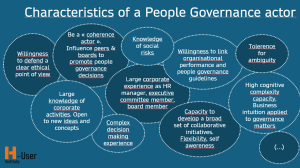Unlocking Organizational Performance: A Conversation with Serge Hubert on People Governance
I recently had the pleasure of sitting down with Serge Hubert, the executive Director of the H-User Institute (The People Governance Institute), to discuss the concept of People Governance. This innovative approach to organisational management is gaining traction in the business world, and we thought it would be useful to explain its principles, significance, and implementation.
What is People Governance ?
People Governance is an integral component of the corporate governance value chain. It represents a holistic approach to performance management that integrates several key elements: Board awareness, ethical leadership, organisational performance, sustainable social risk management, and corporate collaborative performance.
As Serge highlights, “this comprehensive system yields two major outcomes: a culture of trust and enhanced stakeholder accountability. People Governance addresses multiple facets of an organisation’s operations, spanning from board and leadership conduct to technological decisions. Its ultimate aim is twofold: foster business success and achieve strategic sustainability goals.”
As we see, this approach recognizes the interconnectedness of human factors, ethical considerations, and organizational performance in driving sustainable corporate governance.
As Serge puts it, «People governance calls upon leadership skills linked to organisational transformation and the management of cultural change supported by executive management and the board. It requires active collaboration between three key players: the board of directors, the management, and stakeholders. It’s about creating an ecosystem where employees can thrive, contribute meaningfully, and drive organisational success.
People Governance encompasses leadership, culture, talent management, and organisational design, all working in harmony to create a high-performing, engaged workforce.”
The Importance of People Governance
When asked about the significance of this approach, Serge was passionate in his response. “In today’s rapidly changing business landscape, organisations that excel in People Governance have a distinct competitive advantage,” he stated. “It’s not just about attracting and retaining talent; it’s about creating an environment where people can reach their full potential and, in turn, propel the company forward.”
We can outline several key benefits of effective People Governance: enhanced employee engagement: “When people feel valued and see a clear connection between their work and the company’s goals, engagement soars.” Improved decision-making: “By involving employees at various levels in decision-making processes, organizations tap into a wealth of diverse perspectives and ideas.” Increased adaptability: “A well-governed workforce is more agile and better equipped to handle change and uncertainty.” Stronger organisational Culture : “People Governance helps create a cohesive culture that aligns with the company’s values and mission.” Better talent attraction and retention: “Companies known for excellent People Governance become magnets for top talent.” And last but not least better collaboration between the decision makers and the management, the management and the work force.
Implementing People Governance: Where to Start
Recognising the transformative potential of People Governance, I asked Serge for advice on how organisations can begin implementing this approach.
“Coherent human governance simultaneously involves the following players and general skills” said Serge:
“A board of directors and executive management involved in the direction their organisation’s human governance should take. Well informed about the organisation’s social and cultural issues, the Board, together with its management, drafts a policy paper in which it defends the company’s steering principles. This is done with full knowledge of the strategic issues and major projects championed by management.
Executive management and the executive team who act as a ‘transmission belt’ between the Board and the middle management teams. Which transmits, decodes and organises the implementation of the business plan while guaranteeing the management of organisational and human risks. Executive management and its teams are the key players in the behavioural implementation of a ‘collaborative mentoring’ culture. It is an essential tool in achieving the business plan and its projects.
Middle management that works ‘as a transmission belt’ between project teams, employees and management. Middle management is the ‘spokesperson’ and ‘heir’ of decision-making and managerial choices. They are the guarantors of personal development. They create trust through the way they operate, the way they help and the way they assess situations and individuals.”
Serge Hubert emphasised that implementing People Governance is not a one-time event but an ongoing process. “It requires commitment, patience, and a willingness to evolve,” he noted. “But the rewards – in terms of organisational performance, employee satisfaction, and business success – are well worth the effort.”
What are the characteristics of a People Governance Actor
When I asked Serge about what characterises a people governance actor, he smiled and said “we all contribute voluntarily or involuntarily to good people governance”. And went on to share this graphic:

Conclusion
As our conversation drew to a close, I reflected on the transformative potential of People Governance. In a world where human capital is often an organisation’s most valuable asset, this approach offers a framework for unlocking the full potential of a workforce.
Serge Hubert’s insights provide a compelling case for organisations to prioritise People Governance. By aligning people strategies with business objectives, fostering a culture of engagement and development, and creating systems that support and empower employees, companies can create a sustainable competitive advantage.
As an executive search consultant, I’ve seen firsthand the impact of effective people management on organisational success. The principles of People Governance offer a roadmap for companies looking to elevate their human capital strategies and create thriving, high-performing workplaces.
In the words of Serge Hubert, “People Governance is not just about managing employees; it’s about creating an environment where people and businesses can flourish together.” It’s a powerful vision – and one that forward-thinking organisations would do well to embrace.
What can we do to help?
Reach out to us if we can assist you either on implementing People Governance or finding the right talent to deliver it.
Serge Hubert, Executive Director H-User Institute – serge.hubert@huser-institut.com
Michel Grisay, Partner, Hoffman – mg@hoffman.be